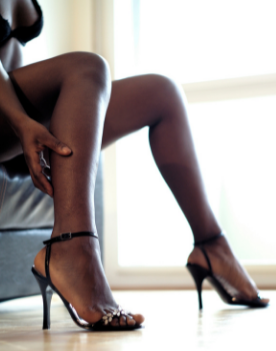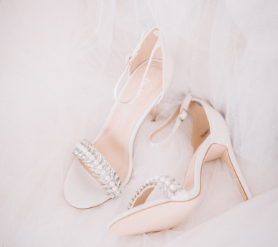
Even when her feet felt so numb and her knees threatened to buckle under her, there was no way she’d kick off her high heel and reduce her chances of being employed.
Shola struggled to maintain her balance on the tiled floors of the conference room as she carefully paced back and forth in her 4-inch stiletto high heels while delivering her opening speech. Had she known that walking would be this much of a struggle between her feet and these slippery tiles, she would have stuck to her flat shoes.
Whoever established that stylish shoes must be painful falls under the myth that ‘beauty is pain.’ Shola would choose comfort a hundred times over this painful elegance that she was visibly trying to portray.
Ruling out high heels from her entire shoe collection, she made a mental note to have her feet massaged after this seminar. She only wished she doesn’t wobble in them and gracelessly fall off the stage as that would be beyond embarrassing.

It is universally accepted by women that a party dress is not complete without a classy pair of high-heeled shoes. This is because they stand taller, appear slimmer and strike a sexier posture whenever they put on high heels.
However, women cannot deny that high-heeled shoes are much less comfortable than sneakers or flats—and they’re always relieved to kick them off after a long day.
Data from the American Academy of Orthopaedic Surgeons (AAOS) in the United States reveals that one 1 out of 6 women have chronic pain in the foot or feet. It also reported that 9 out of 10 of women’s foot issues are attributed to tight shoes.
Another research conducted by Stephen Ogedengbe, MD, a researcher at the University of Benin Teaching Hospital, Nigeria equally agrees that improper footwear accounts for a great number of foot ulcers amongst diabetic females.
Wearing high heel shoes for long periods comes with stress and pressure on several parts of your body. This is because the body tries to adjust and shift its overall weight to compensate for the heel of the high heels shoes. This extra stress can adversely affect your knees, hips, lower back, Achilles tendon and calf muscles.
The increased pressure caused by habitual wearing of heels 2 inches or higher makes the Achilles tendon and calf muscles take different shapes.
The tendon may shorten, and the muscles can stiffen and reshape thereby causing pain in the body’s lower extremities. It is an established fact that high heel shoes negatively impact your lower limb if worn regularly.

There are significant (and severe) health risks of high heel shoes when worn frequently and over long periods. Some of these conditions include:
Note that high heels by themselves do not translate to all the above-mentioned problems. But based on anatomy and genetics, some women are more predisposed than others. Excessive and early-age usage of high heels, also contribute to these issues.

Are you experiencing the consequences of constantly wearing high heels? Here are a few suggestions that can help ameliorate the painful effects and avoid the health risks of high heel shoes:
Beauty must not always be a pain. You can be elegant without having to stress your feet and ankle joints with high heels. The health risks of high heel shoes should not be overlooked and cannot be stressed enough.
So, before you throw caution to the wind, do your due diligence and find shoes that are comfortable. With the help of this article, you can now avoid the health risks of high heel shoes. If you are already experiencing some of these health issues discussed in this article, do not hesitate to Seek Medical Advice from a Doctor.
Telemedicine can be very helpful when it comes to understanding the health risks of high heel shoes. By consulting a doctor online, you can learn about how high heels might be affecting your feet, back, and overall posture. This can be done from your home, making it easier to get the information you need without having to visit a clinic.
Another great thing about telemedicine is that you can get advice on minimising the risks of high heel shoes if you love wearing them. A healthcare provider can suggest exercises to strengthen your feet and legs, recommend shoe inserts to make high heels more comfortable, and even advise on how often you should wear them to avoid long-term damage. This personalized advice can help you make smarter choices about your footwear and avoid the risks of high heel shoes.
Finally, telemedicine can help you spot early signs of problems caused by high heels. If you notice any pain or discomfort, you can quickly consult with a doctor to see if it’s something to worry about. Early detection and treatment of issues like bunions, calluses, or back pain can prevent more serious problems down the road. This makes telemedicine a convenient and effective way to keep your feet and body healthy while enjoying your favourite high heels.
One of the many risks of high heel shoes is that it puts the foot at an odd angle and misaligns the muscles and joints. Ergo, the effects are not limited to the feet. High heel shoes disrupt the natural form of the body, leading to low back, neck and shoulder pain.
For people who wear heels frequently, the risks of high heel shoes include bunions, toe deformities (hammertoes or claw toes), corns and calluses, ankle sprains, ingrown toenails, and constricted blood vessels. High heels alter the position of the joints, causing excess or abnormal stress. This can lead to arthritis and pain.
High heels add height and glitter to a woman’s gait, making her feel more confident and assertive. However, one of the risks of high heel shoes is intense foot pain. High heels place excessive pressure on the feet and toes.
The conditions that result from wearing high heels include hammertoes, bunions, and plantar fasciitis.
The risks of high heel shoes cause long-term damage to the body. They alter the spine’s natural alignment, cause hammertoes, bunions, and plantar fasciitis, shorten muscles and tendons, and increase the risk of osteoarthritis.
American Osteopathic Association. The Real Harm in High Heels
Banner Health (2022). Are High Heels Bad For Your Feet and Health?
Lorkowski, J., & Pokorski, M. (2023). Harmful female footwear: A public health perspective.
healthcareNovember 7, 2024
MedicationNovember 25, 2024
NutritionFebruary 5, 2025
MedicationFebruary 5, 2025








